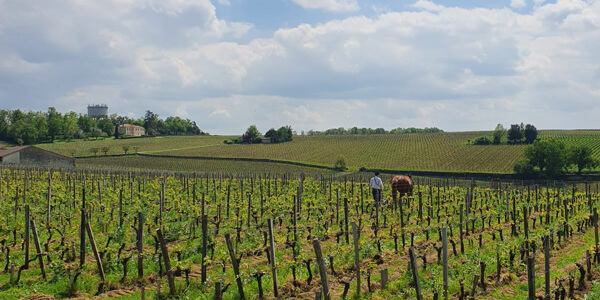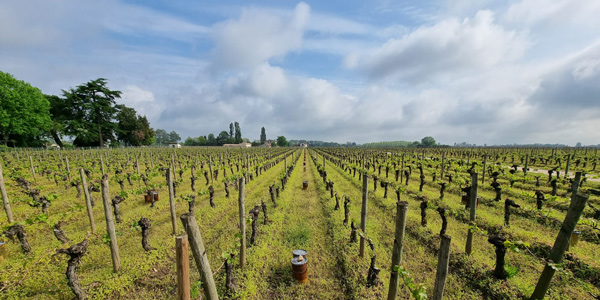
I am going out on a limb with this blog entry, to say that you probably don’t need me to tell you that Lafite, Mouton, Margaux and Haut-Brion will probably be exceptional in the 2022 releases. It is, by now, far from a secret that we’ve got an outstanding vintage on our hands. Indeed, the Bordelais, who are usually a slightly coy bunch, have already very effectively communicated two things – that 2022 was outstanding and that prices will almost certainly be going up. Gulp.
Alongside this, yields also seem to have taken a bit of a hit, owing to both sharp frosts at the start of the season, some rather nasty (if localised) hail and, critically, the drought. Whilst not quite as bad as 2021 (they were 9% up) it still 15% below an average harvest in terms of volume. In essence, if you are able to find allocations of the highly desirable wines, I would jump at the chance.
With the wildfires, which made the news last summer, there has been some fear of smoke taint in the final wines. We can confirm that every report published has attested to it having zero impact, which has included testing and support from experts in both California and Australia.
So what other wisdom can I impart at this stage, having as yet tasted nothing?
In the exceptional vineyards, you (almost) always make exceptional wine. There is an established and eager market for it, and you can adjust your prices depending on both the quality and yield you achieve, with an almost clinical certainty that if X is awarded Y points and costs Z, it will all sell out.
But what of the lesser vineyards?
This, perhaps, is my hunch – my Columbo moment. Lower-classed growths, esoteric Pomerol, one of the 200+ St Emilion carrying the inscription ‘Grand Cru’ which you or I have never heard of – they can’t adjust their price much, but in 2022, a vintage which has already seen various comparisons such as ‘2009, 2010, 2018, 2020’ (more or less any of the warmer, dryer outstanding vintages of the last two decades) they should be great value.
Why? Well, much like the detective slowly rising to tell the crowds who the culprit actually is, this is my professional appraisal. Generally speaking in Bordeaux the harder vintages are the colder ones. Whilst Lafite might have the terroir to ripen grapes exceptionally well even in off years, generally the lesser properties struggle – they produce wines with hard tannins, high acids and a lot of under ripe green flavours.
However, in the hot years, this transformative dose of sunshine allows grapes to fully ripen and deliver some exceptionally well balanced wines. These, however, are not ubiquitous. Work in the vineyard and in the winery are crucial to translating these into the bottle, but that’s where we come in. As well as bringing you the finest of the finest, the Lea & Sandeman team will be tasting hundreds of the other wines Bordeaux has to offer with a hope to unearthing hidden treasures.
Jack Chapman – Head of Private Client Sales
Diving deeper: Bordeaux 2022 weather
What impact does the weather have on the final product? I always find it rather tricky to distil all of the information provided by commentators and whilst it’s impossible to generalise, these for me are the salient points:
2022 was very dry. A lack of rainfall will do three major things:
-
-
-
-
-
- Kill or render useless young vines. Properties relying on these, or with too much of these will be in trouble. Their wine will either be poor, or there will be a lot less of it. A hidden bonus though, is that some wine which was previously made by blending juice from both old & new vines, will be exclusively from old vines and therefore better.
- Create hydric stress which will inhibit ripening (sometimes good for stopping the grapes from over-ripening in really hot years)
- Dehydrate grapes. It will literally reduce the juice available to squeeze out – this is why yield drops (15-30% of water weight was lost in 2022 vs the five year average), but in turn, concentration of flavour will intensify (the flavour is quite literally ‘less watered down’) and acidity will perversely increase, again, because there isn’t so much liquid to dilute it.
-
-
-
-
2022 was really hot in summer, this sort of heat will have a couple of major consequences:
-
-
-
-
-
- Everyone will have more time. Have you ever considered how much time and co-ordination it takes to properly hand-harvest vineyards on the scale of Bordeaux? 2022 was one of the earliest harvests on record, but it was also a very long one because the weather was just that good. If you have 100 hectares across which you’re growing your prized grapes, you will know that a certain 2 hectare plot ripens first, then it might be followed by the 10 hectares up the hill, then another 5 by the river. If there’s a chance that the rain might be closing in, you are going to make quick decisions about when you harvest, and they won’t necessary be the optimum dates. In 2022, with so little threat of inclement weather, everyone was able to just take their time, picking their grapes exactly when they wanted. This will have a huge impact on quality.
- Sugar levels will rise, and acidity will be depleted We’ll be watching out for wine where they perhaps didn’t pick at the right time or exposed their bunches/didn’t manage their canopy properly. In a hot year like 2022, this will result in high alcohol wine with little acidity. Words like ‘flabby’ might even come into play.
- However, although it was hot, 2022 had pretty cool nights. Having grown up on a farm and doing my own bit of viticulture in the UK, I have a bit of an inbuilt barometer and I can recall in 2018 how difficult it was at night to find any sort of comfort given just how hot it was. So, you would expect that 2022 would be the same, but if you can cast your mine back to last year, although the nights were certainly warm, they were rarely uncomfortably so. This diurnal range is critical for the production of high quality grapes as it allows them to cool off a bit at night and retain precious acidity/much fresher fruit qualities. 2022 was a great example of this.
-
-
-
-

